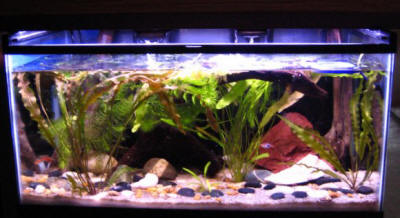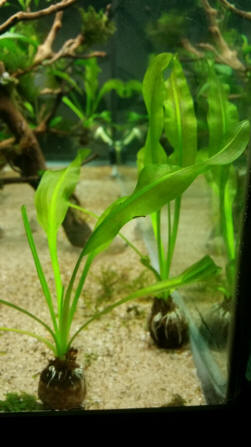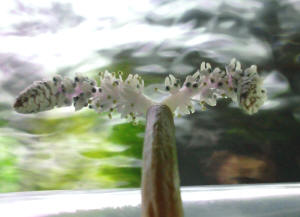|
FAQs on the Genus
Aponogeton
Related Articles: Aponogetons,
Related FAQs:
|

|
|
Madagascar Lace - Aponogeton madagascariensis
3/8/15
Hello, crew.
I have a perplexing situation that I cannot find any information about. I was
hoping you would be able to help. A few weeks ago I purchased Madagascar Lace
bulbs (Aponogeton madagascariensis, I assume, though it could be one of the
other forms) from an online source.
<Nice plant. Disposable. But nice for a while.>
The bulbs arrived with all of their old foliage cut off about a quarter inch
from the top of the corm.
<I see.>
Once submersed in my tank they began to grow quickly and in a few days I started
to suspect that I had a problem. There was no fenestration apparent in the new
leaves.
<Curious.>
I will attach a photo of a week's growth. I contacted the seller and got a very
earnest reply that this is common when buying Madagascar Lace plants as a bulb.
I was told that it takes about 3 months before these leaves will shed and the
typical fenestrated leaves will grow in.
<Really? Not experienced that myself. It's been many years since I grew this
species, but I don't recall the leaves being anything other than fenestrated.
For sure the leaves are initially whole but a very obvious crisscross pattern is
always apparent, and before long the holes start appearing.>
The seller saw my photos and said they they were definitely Madagascar Lace and
that this was very common.
<To be honest looks more like Aponogeton ulvaceus to me. Definitely isn't a
standard issue Aponogeton madagascariensis of the sort you paid for/expected.>
My own research has not been able to discover references to such a phenomenon.
Have you ever heard of Aponogeton bulbs growing different leaf forms for part of
their lives?
<Nope.>
Also, these bulbs had already been growing prior to shipping, as indicated by
the cut foliage.
<Not uncommon. I believe the corms are grown emerse in greenhouses, cut back,
then shipped. Historically this species has always been treated as an annual
novelty, unlikely to grow continuously without a cooler, above-the-waterline
stage like it'd experience in the wild. Since the corms are cheap (at least in
the UK) buying them as something for a few months to a year is no big deal.>
Thank you for your assistance.
Ashley
<I would contact the retailer and ask for a replacement, perhaps linking him
back to this email. Mistakes happen, and this is likely one of them. Hope this
helps, Neale.> |
 |
|
Aponogeton madagascariensis, repro./inflorescence
5/11/2011
I love what you guys are doing! Since I constantly use this site
as a reference for myself and promote this site to customers, I
thought I should share things that I cannot yet find on your
site.
<We thank you>
I have attached a few photos of our Madagascar Lace (Aponogeton
madagascariensis) flowering. The flowers are very light purple
and very fragrant. The flower stalk seems to have only taken 3
days to bloom and reaches over 2ft.
<Ah, very nice>
This tank a 65G with angels, Neons, and Japanese algae shrimp.
Substrate is Seachem's Flourite Black sand, filtration is 1x
Eheim 2217 and 1x Rena XP4.
This tank gets 192W from 2x96W CL Colormax power compacts.
No CO2 is used, but air bubbles are released when lights are out
at night.
<Interesting... Usually such gas is released during periods of
peak photosynthesis>
Krystal Wessels
<Cheers! Bob Fenner>
|
|


|
| Transplanting Aponogetons 5/19/07 Hi there
Crew, <Nicole> I haven't been able to find too much
information about this topic online, so I thought I would ask you
fine folks. I'm facing a move in the next few weeks, and would
like some advice. <Okay> One of my tanks is moderately
planted. The substrate is just plain old silica sand. <Not
generally useful for planted systems... too sharp, smooth,
chemically inert...> Aponogetons have taken over! <Ah yes...
"bring their own food"> One of the plants has flowered
and taken to seed, so there are 4-5 tiny plants growing in little
nooks and crannies, mostly towards the back out of sight. The plant
that has flowered has many long leaves that float at the surface,
shading the tank. <Neat> The other two main plants are
Aponogeton crispus, I believe. One is younger and thriving, the
other has browned and the leaves have gotten very long. <A lack
of... nitrogen likely> All of these plants seem really too big
to be in a 15 gallon tank, but they seem to be faring all right. I
fertilize twice monthly with Hagen's Iron Enriched NutraGro,
<Ohhh> and perform small daily water changes of about 1/2
gallon to a gallon. <Wow, good practice> I use a teeny gravel
vacuum - a piece of rigid airline tubing connected to regular
airline tubing. This gets the particles off the sand without too
much disruption. My questions are these: what would be the best way
to transplant these plants? <Mmm, to pull out as much of the
existing root structure and "bulb", along with a good bit
of the substrate... and place all in a new setting... best in a pot
of some sort, that you can move easier going forward> I chose
the sand for aesthetic reasons, but is there another sandy
substrate that the plants would prefer, that might provide a bit of
nutrient? <Oh yes... Please read here: http://www.wetwebmedia.com/PlantedTksSubWebIndex/substraags.htm
and the linked files above> The plant on the left (picture
attached) doesn't look very healthy any longer but the leaves
don't fall off or get holes in them, they are just a rusty
brown to olive color. <Do take a read on "the
Krib.com" re nutrient deficiency diseases> Before
transplanting, might it help this plant to receive a radical
pruning? <Yes> They all could probably use some pruning, but
I am not sure how to go about it - should I just pluck out the
stems? <Mmm, no... Pinch, crush the unwanted leaves near the
base...> This tank may seem like a tangled mess, but it all came
together in a sort of random fashion! I'll know more next time
about how to go about it. <Ah, yes> Lastly, would it be
beneficial to alternate NutraGro with Leaf Zone? <Mmm, yes... do
read on the Krib re PMDD...> I have heard different opinions
about whether to use different kinds of fertilizers or stick with
just one kind. <There are better products, lines...> Sorry
for all the questions! Thank you so much for your help. <Thank
you for sharing. Bob Fenner> |
|

|
Growing water plants... - 05/01/07 hello, I
recently bought betta plants for my little betta. However when putting
in the spuds, <? Spuds?> I let them sink and now a few days later
there looks like a white film around the spuds. Is this normal?
<Maybe... are these Aponogeton bulbs?> I've looked all over
the place yet no one has an answer for the white film slime stuff
that's on the spuds. are they bad spuds? will they hurt my betta?
what's going on? I need help! PLEASE!!! Paul <Do take a look on
the Net re the above genus... likely whatever these plant parts are,
they need to be planted... Perhaps a bit of decomposer populations are
taking advantage... Plant them. Bob Fenner>
Sprouting Old Plant Bulbs 9/8/06
Disregard the title if it sounds like an emergency - it's not. No
fish are suffering! Just my pride. What I have done is so idiotic!
Hopefully I will not be barred from ever writing you again. < Hey,
we live off this stuff!> I was cleaning out a section of my utility
room (mostly full of fish equipment and hurricane prep -- after all,
this is Florida here) and I came across this package of plant bulbs I
must have purchased a few years ago and forgot about. They are Aquarium
Plant Life brand, a package of about 5 bulbs that you're supposed
to be able to drop into an aquarium and have root in a few days. Ok, so
I also stumbled across my old 10 gallon glass tank and a bag of blue
and black gravel mix, and a bag of perlite and vermiculite mix. (In
case you can't tell, I mix things.) Somehow, I thought I would
experiment with all three of these! So I covered the bottom of the tank
with perlite and vermiculite --which I figured was probably not
aquarium safe but thought it would be ok, since I was only meaning
half-heartedly to grow these plants and never add fish-- then topped it
off with nearly an inch of the blue and black aquarium gravel. I
mistakenly thought this layering would give the plants some nice deep
airy rooting substrate with an (albeit thin) anchor of dense gravel!
Well, I poured the water in from my faucet attachment and boy oh boy do
I have a mess. I put a screened top over the tank and a shoplight is
casting ghostly formations into the brown water. I cannot imagine this
ever clarifying. After reading online about perlite and vermiculite
(apparently these materials are used for pool construction and
fireproofing? hmm...) I can see now that these probably will not ever
do well submerged. I netted out most of the perlite, which floated to
the top as though made of Styrofoam. I believe it's the vermiculite
that is causing the brown clouding of the water. I dropped the bulbs in
already along with a couple of fertilizer tabs... once the water filled
the tank it was impossible to scoop them out, like bobbing for apples!
Should I dump this mess outside? < Take the tank outside. Pour the
water and floating things through a fish net. Pluck out the bulbs and
dump the rest into your flower bed. Rinse the gravel in the 10 gallon
with a garden hose until it overflows clear and the gravel is clean.
Empty the water and set the tank back up where you want it. Place the
bulbs back into the tank. If they spout at all then you can worry about
lighting and fertilizers then. If they don't sprout then just fish
them out with a net.> I could do so easily, the tank is right near
the front door. It probably wouldn't hurt the plants outside. I was
tempted to tonight, but I thought I would ask your opinion. I don't
think this stuff will ever settle... if it does, isn't it bound to
cloud right up again? Also after mucking around in this water, my hands
feel dry as all get-out. Maybe it has to do with the fact that these
are pool construction and flame proofing materials!! ;) I feel so dumb
having this tank which now looks like a....liquid intestinal
evacuation! So, would it ever be *feasible* to grow these plants of
*questionable* origin in this *experimental* substrate, just add hard
tap water and fertilizer tabs? I'm so sorry to ask, but I would
love to know... if not, I'd be happy to pitch the fowl soup...
Thank you for even reading this far! Nicole < Plant the bulbs. It is
the only way we will know if they are any good.-Chuck>
Hardy Aponogetons - 06/07/2005 I got some live aquarium plants
called hardy Aponogeton bulbs from a pet store and I don't know
much about them; could you tell me more about them? <Aponogetons are
pretty neat plants. Some are very easy to grow, and others require a
bit of attention; chances are, at least some of your bulbs will grow
into nice plants, maybe all of them. Here is an article about this
genus of plants: http://www.thekrib.com/Plants/Plants/apons-randall.html
. If you go to http://www.google.com and do a search on
the word "Aponogeton", you'll get tons of information. My
own personal favorite is Aponogeton ulvaceus, which is a very beautiful
plant with broad, wavy leaves....> Please Email me back with info.
<There is a wealth of information awaiting you on the web; read that
article and do a Google search, and you'll soon know all you
like.> Thanks. <You bet. Wishing you well,
-Sabrina>
|
|

